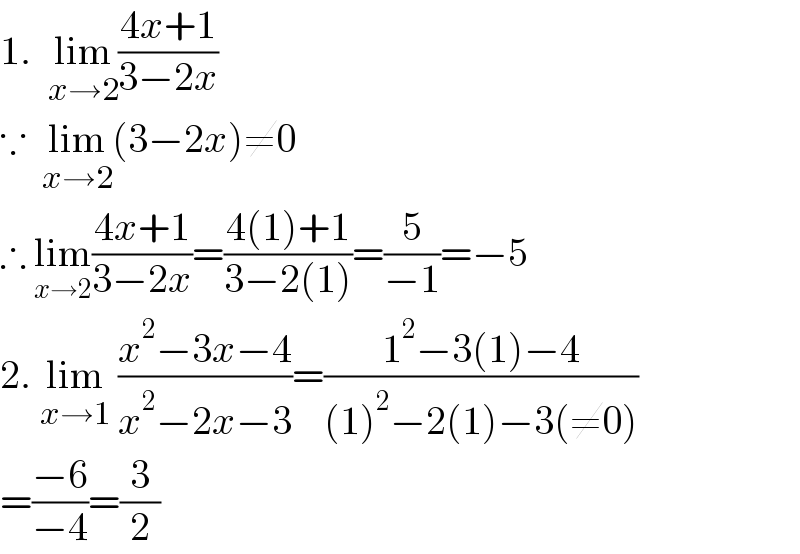
Question Number 176710 by eka last updated on 25/Sep/22

Answered by a.lgnaoui last updated on 26/Sep/22

$$\:\mathrm{3}.\:\:\:{lim}_{{x}\rightarrow−\mathrm{1}} \:\:\frac{\sqrt{{x}^{\mathrm{2}} +\mathrm{3}}}{{x}^{\mathrm{2}} −\mathrm{2}}=\frac{\sqrt{\mathrm{4}}}{−\mathrm{1}}=−\mathrm{2}\:\:\:\:\:\:\:\:\:\:\:\:\:{anser}\:\left(\boldsymbol{\mathrm{D}}\right) \\ $$$$\mathrm{4}.\:\:\:\frac{{x}^{\mathrm{2}} +\mathrm{2}{x}−\mathrm{8}}{{x}−\mathrm{2}}=\frac{\left({x}−\mathrm{2}\right)\left({x}+\mathrm{4}\right)}{{x}−\mathrm{2}}={x}+\mathrm{4} \\ $$$$\:\:\:{lim}\frac{{x}^{\mathrm{2}} +\mathrm{2}{x}−\mathrm{8}}{{x}−\mathrm{2}}=\mathrm{2}+\mathrm{4}=\mathrm{6}\:\:\:\:\:\:\:\:\:\:\:{anser}\:\:\left(\boldsymbol{\mathrm{D}}\right) \\ $$
Answered by Rasheed.Sindhi last updated on 25/Sep/22

$$\mathrm{1}.\:\:\underset{{x}\rightarrow\mathrm{2}} {\mathrm{lim}}\frac{\mathrm{4}{x}+\mathrm{1}}{\mathrm{3}−\mathrm{2}{x}} \\ $$$$\because\:\:\underset{{x}\rightarrow\mathrm{2}} {\mathrm{lim}}\left(\mathrm{3}−\mathrm{2}{x}\right)\neq\mathrm{0} \\ $$$$\therefore\:\underset{{x}\rightarrow\mathrm{2}} {\mathrm{lim}}\frac{\mathrm{4}{x}+\mathrm{1}}{\mathrm{3}−\mathrm{2}{x}}=\frac{\mathrm{4}\left(\mathrm{1}\right)+\mathrm{1}}{\mathrm{3}−\mathrm{2}\left(\mathrm{1}\right)}=\frac{\mathrm{5}}{−\mathrm{1}}=−\mathrm{5} \\ $$$$\mathrm{2}.\:\underset{{x}\rightarrow\mathrm{1}} {\mathrm{lim}}\:\frac{{x}^{\mathrm{2}} −\mathrm{3}{x}−\mathrm{4}}{{x}^{\mathrm{2}} −\mathrm{2}{x}−\mathrm{3}}=\frac{\mathrm{1}^{\mathrm{2}} −\mathrm{3}\left(\mathrm{1}\right)−\mathrm{4}}{\left(\mathrm{1}\right)^{\mathrm{2}} −\mathrm{2}\left(\mathrm{1}\right)−\mathrm{3}\left(\neq\mathrm{0}\right)} \\ $$$$=\frac{−\mathrm{6}}{−\mathrm{4}}=\frac{\mathrm{3}}{\mathrm{2}} \\ $$
Answered by Rasheed.Sindhi last updated on 25/Sep/22

$$\mathrm{3}.\underset{{x}\rightarrow−\mathrm{1}} {\mathrm{lim}}\frac{\sqrt{{x}^{\mathrm{2}} +\mathrm{3}}}{{x}^{\mathrm{2}} −\mathrm{2}}=\frac{\sqrt{\left(−\mathrm{1}\right)^{\mathrm{2}} +\mathrm{3}}}{\left(−\mathrm{1}\right)^{\mathrm{2}} −\mathrm{2}\:\left(\neq\mathrm{0}\right)} \\ $$$$=\frac{\mathrm{2}}{−\mathrm{1}}=−\mathrm{2} \\ $$$$\mathrm{4}.\underset{{x}\rightarrow\mathrm{2}} {\mathrm{lim}}\frac{{x}^{\mathrm{2}} +\mathrm{2}{x}−\mathrm{8}}{{x}−\mathrm{2}}=\underset{{x}\rightarrow\mathrm{2}} {\mathrm{lim}}\frac{\left(\cancel{{x}−\mathrm{2}}\right)\left({x}+\mathrm{4}\right)}{\cancel{{x}−\mathrm{2}}} \\ $$$$=\mathrm{2}+\mathrm{4}=\mathrm{6} \\ $$
